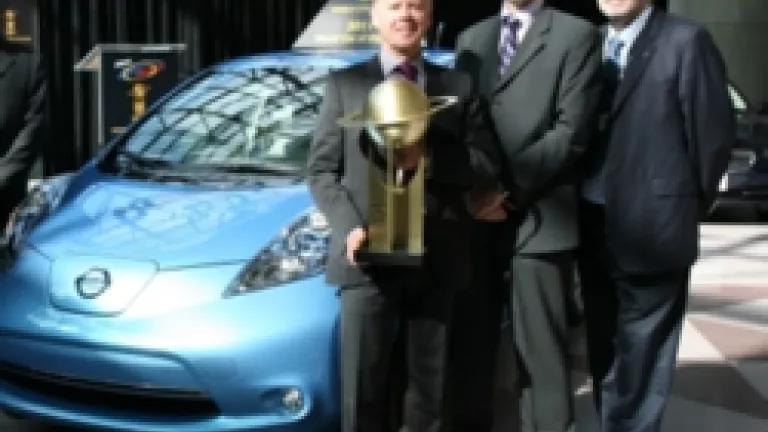
In this blog (Part 2 of 2), I take a swing at describing ways that electric-drive vehicles can help reduce our pain at the gasoline pump, benefit our economy, and clean up our air. Yesterday, Secretary LaHood of the U.S. Department of Energy spoke at the Electric-Drive Transportation Association (EDTA) Conference and the progress being made to ensure:
“Electric and hybrid vehicles are becoming the norm, not the exception… In terms of the pain at the pump, households are paying more for transportation than education, health care, and anything else in the house.”
At today’s New York International Auto Show, the all-electric Nissan Leaf won the 2011 World Car of the Year Award while the plug-in hybrid electric vehicle, GM Chevy Volt, won the World Green Car of the Year Award. Plug-in electric vehicles are truly coming back with a vengeance.

The EDTA conference and NY Auto show reinforce the case that President Obama’s plan for one million electric-drive vehicles by 2015 is ultimately achievable. Ultimately, this plan will help bring a slew of great new fuel efficient products into the hands of consumers, spur American ingenuity, reduce our pain at the pump, and provide benefits in unexpected ways.
1. Reduces Our Pain at the Pump Now: We now have a commercialized solution that gives consumers more choice over what they pay to fuel up. Today’s average conventional gasoline driver getting 25 MPG (miles per gallon) is paying about $60 for each tank of gas, assuming the national average of $3.84/gallon* Switching over to an electric-drive vehicle, he or she will be paying the equivalent of about $15 for each “tank” of electricity to go the same distance. Over the course of a year, the gasoline driver will be sending nearly $1,850 to oil companies, with a significant fraction of that value being sent overseas. By contrast, the owner of the electric-drive vehicle will be spending only $450 annually on electricity to go the same distance, with all of that value sent to domestic, local utility companies and generators.** That’s $1,400 in savings annually for an electric-drive owner – real money in the bank.
2. Fuel Dollars Stay Here And Promote Domestic Jobs That Won’t Be Exported: Not as recognized is the fact the “fuel” expenditures spent on electricity will not go to oil companies and sent overseas. Instead, PEV drivers will be paying for electricity and charging services provided by domestic local utilities and charging service providers, respectively. Those are jobs that will stay here for the foreseeable since electricity is domestically produced. And what about those fuel savings? A portion of that money in the bank will enter back into our economy, helping support further job creation in other sectors.
3. Provides the Ability for Consumers to Make Their Vehicles Truly 100% Carbon Neutral: Carbon emissions from the production of oil are getting increasingly worse. Growing U.S. dependency on dirty fuels produced from sources like Canadian tar sands that emit 20% higher emissions on a well-to-wheels basis only compound our problems. But, as my colleague, Luke Tonachel, writes:
“Considering the national average electricity generation mix, first-generation plug-in vehicles like the Chevy Volt and Nissan LEAF cut emissions by 40 percent from today’s cars. In places with cleaner grids, the benefits are larger. The opposite holds true, of course. Dirtier grids mean the benefits are lower. However, even in regions that are heavily dependent on conventional coal plants, plug-in vehicles are cleaner than conventional cars.”
We will need to continue cleaning up all sources of transportation fuels, including the electricity mix, but today many consumers have the opportunity to purchase cleaner electricity through green utility rates. Going forward, one can also envision utility programs that help link plug-in electric vehicle charging with intermittent renewable generation or solar on rooftops. And clean energy policies that help move us to renewable electricity, such as the 33% renewable portfolio standard just adopted in California, will help clean up our transportation sector simultaneously.
And that in my book, is a win-win-win for our pocket-books, our economy, and our environment.
*Assumes a 16 gallon tank refill. http://www.eia.doe.gov/oil_gas/petroleum/data_publications/wrgp/mogas_home_page.html
** Assumes a $0.11/kWh cost of electricity, today’s national average price. In some parts of the country, reduced rates are offered for charging during off-peak hours. The average vehicle travels about 12,000 miles per year.




